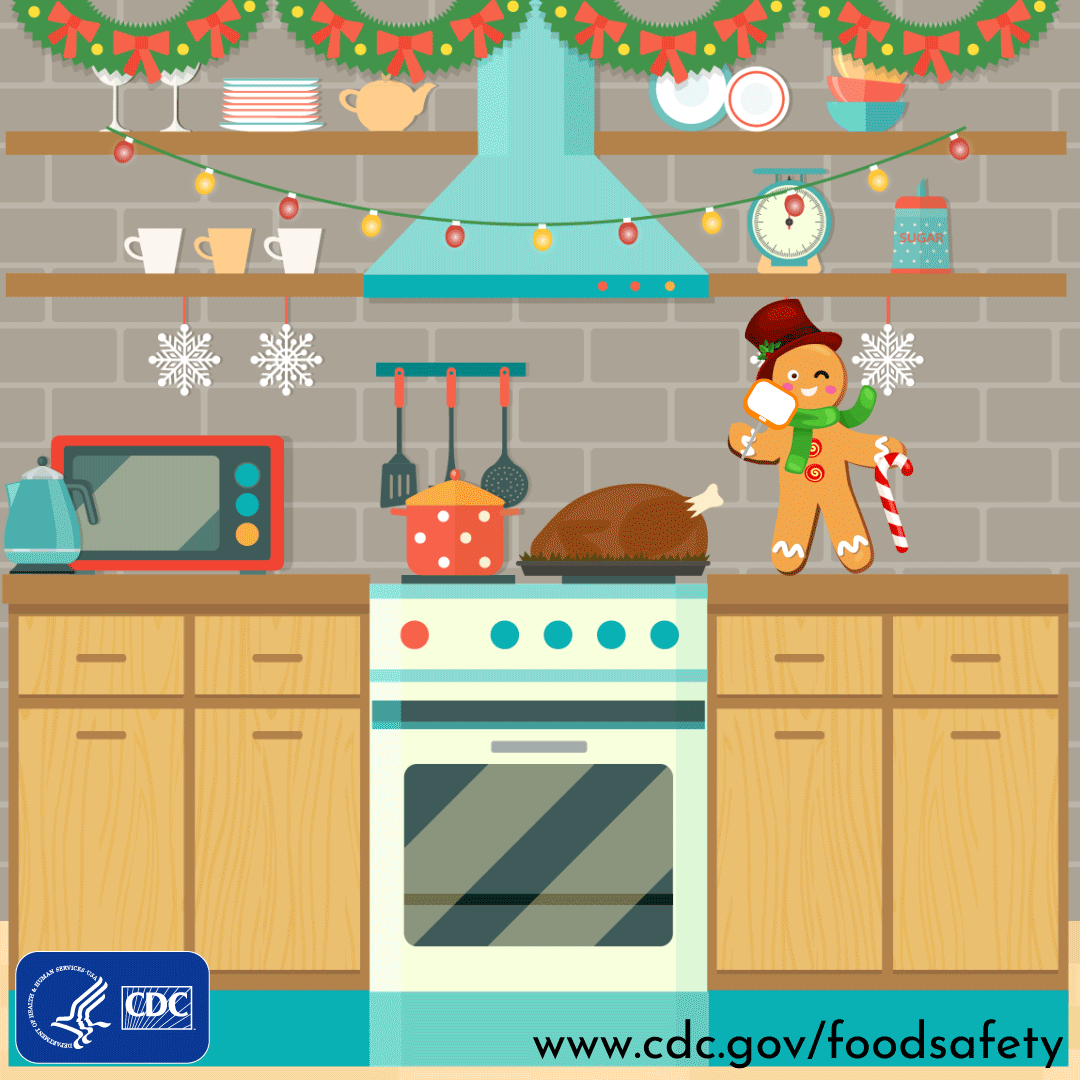 Local health departments (LHDs) are on the front lines of foodborne illness prevention and response. LHDs are responsible for food safety inspections, epidemiological surveillance, the investigation of foodborne illness, and educating the public on food safety. As we enter the time of year when seasonal gatherings abound, we are reminded that LHDs are an essential part of the process to ensure that food is safe to eat in public venues – and at home. The winter holidays and the start of a new year offer many opportunities to celebrate with family and friends. As you toast to good times, don’t let food poisoning spoil your festivities. To help LHDs educate their communities on basic food safety principles, the Centers for Disease Control and Prevention’s (CDC’s) Division of Foodborne, Waterborne, and Environmental Diseases has compiled some tips and tricks to help people spread joy, not germs.
Local health departments (LHDs) are on the front lines of foodborne illness prevention and response. LHDs are responsible for food safety inspections, epidemiological surveillance, the investigation of foodborne illness, and educating the public on food safety. As we enter the time of year when seasonal gatherings abound, we are reminded that LHDs are an essential part of the process to ensure that food is safe to eat in public venues – and at home. The winter holidays and the start of a new year offer many opportunities to celebrate with family and friends. As you toast to good times, don’t let food poisoning spoil your festivities. To help LHDs educate their communities on basic food safety principles, the Centers for Disease Control and Prevention’s (CDC’s) Division of Foodborne, Waterborne, and Environmental Diseases has compiled some tips and tricks to help people spread joy, not germs.
Properly Prepare.
- Wash your hands. Be sure to wash your hands with soap and water before and after preparing food; after
 touching raw meat, raw eggs, or unwashed vegetables; and before eating or drinking.
touching raw meat, raw eggs, or unwashed vegetables; and before eating or drinking. - Keep foods separated. Keep meat, poultry, seafood, and eggs separate from all other foods at the grocery and in the refrigerator. Prevent juices from meat, poultry, and seafood from dripping or leaking onto other foods by keeping them in containers or sealed plastic bags. Store eggs in their original carton in the main compartment of the refrigerator.
- Use pasteurized eggs for dishes containing raw or lightly cooked eggs, such as homemade eggnog, Caesar dressing, hollandaise sauce, and tiramisu. Salmonella and other harmful germs can live on both the outside and inside of normal-looking eggs.
- Safely thaw your turkey. Thaw turkey in these ways: In the refrigerator; in a sink of cold water that is changed every 30 minutes; or in the microwave. Do not thaw foods on the counter. A turkey must thaw at a safe temperature to prevent harmful germs from growing rapidly.
Cook with Care.
- Cook food thoroughly. Meat, poultry, seafood, and eggs can carry germs that cause food poisoning. Use a food thermometer and our cooking chart to ensure these foods have been cooked to a temperature hot enough to kill germs. Before slicing roasts, chops, steaks or fresh ham, let them rest for 3 minutes after removing from the oven or grill.
- Keep food out of the “danger zone,” which is between 40°F and 140°F. Bacteria can grow rapidly at room temperature. After food is cooked, keep hot food hot and cold food cold. Refrigerate or freeze any perishable food within 2 hours. The temperature in your refrigerator should be set at or below 40°F and the freezer at or below 0°F.
- Do not eat uncooked dough or batter. Dough and batter made with raw flour or raw eggs can contain harmful germs, such as E.coli and Salmonella. Do not taste or eat raw dough or batter, including dough for cookies, cakes, pies, biscuits, pancakes, tortillas, pizza, or crafts. Do not let children taste raw dough or batter or play with raw dough at home or in restaurants.
Protect the Pregnant.
Although everyone wants to keep food safe during the holidays, it is especially important for pregnant women to do so because they are at increased risk of food poisoning.
- Do not drink or eat raw or unpasteurized milk and products made with it. Raw or unpasteurized milk and products made with it can contain harmful germs, including Listeria.
- Do not eat soft cheeses such as queso fresco, Brie, Camembert, feta, goat cheese, or Roquefort, if they are made from raw or unpasteurized milk. Pregnant women and their newborns are much more likely to get a Listeria infection, which can cause miscarriages, stillbirths, and preterm labor.
- Be aware that Hispanic-style cheeses made from pasteurized milk, such as queso fresco, also have caused Listeria infections, most likely because they were contaminated during cheese-making.
- Do not eat or drink other raw or unpasteurized products, such as juice or cider.
- Be careful with seafood. Do not eat refrigerated smoked seafood unless it is in a cooked dish, such as a casserole, or unless it is canned or shelf-stable.
- Be aware of holiday beverages. To reduce the possibility of fetal alcohol syndrome, watch out for holiday punches and eggnogs that contain alcohol. Avoid eggnog entirely unless you know it contains no alcohol and is pasteurized or made with pasteurized eggs and milk.
Learn More…
To learn more about keeping yourself and your guests safe, happy, and healthy this holiday season, check out the resources below. Happy holidays!








